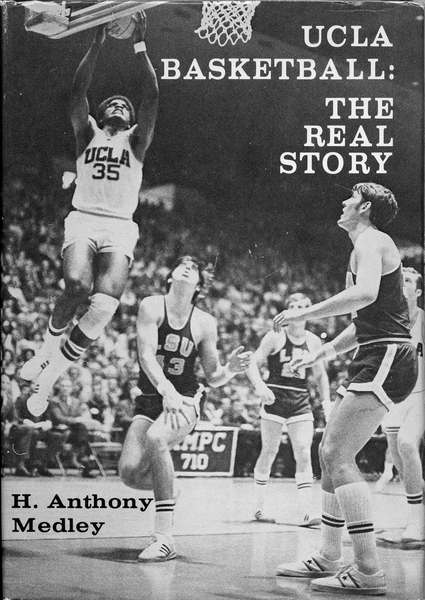|
Out of print for more than 30 years, now available for the first time as an eBook, this is the controversial story of John Wooden's first 25 years and first 8 NCAA Championships as UCLA Head Basketball Coach. This is the only book that gives a true picture of the character of John Wooden and the influence of his assistant, Jerry Norman, whose contributions Wooden ignored and tried to bury. Compiled with more than 40 hours of interviews with Coach Wooden, learn about the man behind the coach. The players tell their stories in their own words. Click the book to read the first chapter and for ordering information. Also available on Kindle. |
|
O.J.: Made in America Part I (2/10) Part II (8/10) by Tony Medley Runtime (approximately 3 hours) Not for children. Documentaries are wonderful tools for revealing truths hitherto unknown. They are also wonderful tools for people bent on mischief to twist facts to fit their biases. They can be misused by the documentarian by what he or she chooses to show and chooses not to show. Katie Couric is now the poster child for deceptive editing for the disgracefully deceitful editing she made on her recent gun control documentary. She first defended it, but when even her fellow lefties were against her, she backtracked and apologized, but only because she was between a rock and a hard place. I have only seen parts 1 and 2 of this ESPN films 30 For 30 Special, but just from these two parts it is apparent that director Ezra Edelman is leading the viewer down his primrose path. To start off with and to give Edelman some credit, however, my guest at the screening has always maintained that O.J. Simpson did not kill Nicole Brown Simpson. After viewing this screening, she told me that she had now changed her mind and is convinced that O.J. did, indeed, murder Nicole. So Ezraís notion is not to support the idea that O.J. is innocent. Rather, it seems to me from watching these two episodes, Ezra is attempting to justify the juryís reaching a decision of Not Guilty when the overwhelming evidence points toward guilt just because O.J. is a black man and this is a way of fighting back against what Ezra perceives is unfairness toward blacks by the American system of criminal justice. He does this by, for example, presenting a bunch of ďfactsĒ that could tend to justify the riot of black people after the Simi Valley not guilty verdict in the case against the LAPD policemen who violently beat up Rodney King in 1991. In order to incite outrage in the viewer, Edelman shows the beating of King approximately 10 times. But the far more vicious attack a few days later by the rioters on white truck driver Reginald Denny, which includes a nauseating shot of a rioter dropping a huge rock directly on Dennyís head and leaving him unconscious and bleeding in the middle of a busy street, is only shown once. He also shows other incidents of LAPD misconduct in the black community, but never shows any actions by the LAPD protecting black people. If you see this film, you come away with the feeling that the LAPD is arm in arm with the KGB and the Gestapo. But Ezra conveniently neglects to mention that the mayor of Los Angeles during this entire period was a black man, Tom Bradley, a former LAPD officer. Worse, most of the old clips he uses are of horrible quality. I canít believe that he couldnít get clips from the Ď60s and later that werenít sharp and clear. He must have had some sort of ulterior motive to show such degraded clips, but I donít know what it was. The film would have been much better with higher quality clips. He also puts down O.J.ís phenomenal success outside of football, especially with his Hertz commercials, and his likeability, implying that in so doing he was abandoning the fact that he was a black man. Apparently Edelmanís idea is that blacks should not strive for success in American society because thatís just sucking up to the white man. Edelman represents this as being ďa history of race over the last several decades.Ē It is nothing of the sort. It is a biased, one-sided presentation without any context or contrary view. All his talking heads (and there arenít many of them) are either blacks with an agenda or old, white, male leftists who expound at length. Edelman doesnít have the integrity to show someone like Thomas Sowell, who undoubtedly has a different viewpoint. Why? Is it because Edelmanís goal isnít to present the truth, itís to present his point of view as a fact without any countervailing opinion? Edelmanís editing is not only biased, itís sloppy. As an example, whenever these talking heads appear, they are only identified once. Whenever a documentarian shows a talking head, that head should be identified with a graphic. And it should be done each time the head appears, not just once, because most viewers canít remember who is who throughout a long film. Part 1 is such an opinionated set up it is agonizing to watch. Part 2 deals with O.J.ís relationship with Nicole and shows O. J. as a brutal, violent person, despite his outward charm. I found Part 2 very interesting. However, I cannot rate the whole series because I have not seen it in its entirety. If I am correct in that the whole point of this is to justify the juryís Not Guilty verdict, I would not rate it highly because it looks to me as if it is little more than propaganda. But I donít know what comes in the next three episodes. |
|
|
